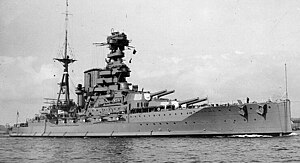HMS Barham (04)

| |
| History | |
|---|---|
| Name | HMS Barham |
| Laid down | 24 February 1913 |
| Launched | 31 October 1914 |
| Commissioned | 19 October 1915 |
| Fate | 25 November 1941 sunk by U-331 |
| General characteristics | |
| Class and type | Queen Elizabeth class battleship |
| Displacement | list error: <br /> list (help) 29,150 tons (standard) 33,000 tons (full load) |
| Length | 643 ft 3 in (196.06 m) |
| Beam | 104 ft (32 m) |
| Draught | 33 ft (10 m) |
| Propulsion | 24 Babcock & Wilcox 3-drum boilers, 4 parsons geared turbines, 4 shafts |
| Speed | 25 knots (46 km/h) (when commissioned) |
| Range | 8,600 nautical miles (15,900 km) at 12.5 knots (23.2 km/h) |
| Complement | 1,124–1,184 |
| Armament | list error: <br /> list (help) 8 × 15 in (381 mm) (4×2) 14 × 6 in (152 mm) 2 × 12 pdr 4 × 21 in (533 mm) torpedo tubes |
| Armour | list error: <br /> list (help) 6–13in (152–330 mm) midships belt 2.5–5in (64–127 mm) deck 13 in (330 mm)turret face 11 in (279 mm) conning tower sides |
HMS Barham (pennant number 04) was a Queen Elizabeth-class battleship of the Royal Navy named after Admiral Charles Middleton, 1st Baron Barham, built at the John Brown shipyards in Clydebank, Scotland, and launched in 1914.
Service
In World War I, she collided with her sister-ship Warspite in 1915. In 1916, she was Admiral Hugh Evan-Thomas's flagship of the 5th Battle Squadron temporarily attached to Admiral David Beatty's Battlecruiser Fleet at the battle of Jutland, where she received five hits and fired 337 shells.
During the 1926 general strike she and Ramillies was sent to the River Mersey to land food supplies. She was less extensively modified between the wars than her sisters. Among her captains was Percy Noble.
In World War II she operated in the Atlantic and Mediterranean. She was damaged by a German submarine torpedo in December 1939, while at sea north of the British Isles.

In September 1940, she took part in Operation Menace, a British naval attack on Dakar, Senegal prior to a landing by the Free French. Barham engaged the French battleship Richelieu. On 25 September, the Richelieu hit Barham with a 380 mm shell. The French submarine Bévéziers hit the battleship HMS Resolution with a torpedo the same day. Operation Menace was abandoned. Barham then joined Force H at Gibraltar, taking part in several Malta Convoys.
At the end of 1940, Barham joined the Mediterranean Fleet, taking part in the Battle of Cape Matapan in March 1941 and receiving bomb damage off Crete in May.
On 21 April, 1941, under the command of Admiral Cunningham, Barham along with battleships Warspite and Valiant as well as the cruiser Gloucester and various destroyers, attacked Tripoli harbour.[1]
Sinking
On 25 November 1941, while steaming to cover an attack on Italian convoys, Barham was hit by three torpedoes from the German submarine U-331, commanded by Lieutenant Hans-Dietrich von Tiesenhausen. The torpedoes were fired from a range of only 750 yards providing no time for evasive action, and stuck so closely together as to throw up a single massive water column. As she rolled over to port, her magazines exploded and the ship quickly sank with the loss of over two thirds of her crew.

Aftermath
The British Admiralty was immediately notified of the sinking on 25 November 1941. However, within a few hours they also learned that the German High Command did not know the Barham had been sunk.
Realizing an opportunity to mislead the Germans, and to protect British morale, the Admiralty censored all news of Barham’s sinking and the loss of 861 British seamen.
After a delay of several weeks, the War Office decided to notify the next of kin of Barham’s dead, but they added a special request for secrecy. The notification letters included a warning not to discuss the loss of the ship with anyone but close relatives, stating it was "most essential that information of the event which led to the loss of your husband's life should not find its way to the enemy until such time as it is announced officially..."
By late January 1942, the German High Command had realized Barham had been lost. The British Admiralty informed the press on 27 January 1942 and explained the rationale for withholding the news.
At a seance in Portsmouth in late November 1941, Helen Duncan, a Spiritualist medium from Callander, Scotland, announced that she had contacted a dead sailor who had told her that his ship, HMS Barham, had recently been sunk. Duncan was not arrested in the aftermath of the Barham incident, but in 1944 was arrested during a seance and convicted under the British Witchcraft Act of 1735 and sentenced to 9 months in prison.
Film of the sinking has been reused many times in documentaries and in at least one film, Earth vs. the Flying Saucers (where it was shown as an American destroyer), in the film Task Force (as a Japanese carrier), and in The Battle of Okinawa (film) (where it stands in for the IJN Yamato).
A subsequent Royal Navy Court of Enquiry ascribed the ship's final magazine explosion to the detonation en masse of 4-inch anti-aircraft ammunition stored in wing passages adjacent to the main magazines (experience of prolonged air attacks in earlier operations had shown that the stowage capacity of the AA magazines was inadequate, and extra ammunition was shipped in any convenient void spaces.)
Notes
- ^ Winston S. Churchill, The Grand Alliance. p.241.
